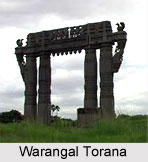 Warangal is located in Warangal District of Telangana. Warangal lies along the Chennai-Kazipet-Delhi rail route.
Warangal is located in Warangal District of Telangana. Warangal lies along the Chennai-Kazipet-Delhi rail route.
The city of Warangal is famous for its beautiful lakes, temples and wildlife along with its rich antiques and relics. A thousand-pillared temple, built in 1162, is located within the city itself. Warangal is now a commercial and industrial centre. Two walls once surrounded Warangal fort, lying southeast of the present-day city, traces of the outer wall remain, as do the four stone gateways (`sanchar`) of the inner wall.
History of Warangal
Warangal was the ancient capital of the Kakatiyas, an Andhra dynasty, whose Prola Raja founded the place in the 12th century AD. However, some also identify it with Worakalli, the capital of the Adeva Rajas of Tuluva Andhra or Telengana in the 8th century AD. The ancient name of Warangal was known to be Orugallu or Omtikonda on account of huge boulder like hillock situated near the Swayambhu Shiva Temple and is also called "Ekasilanagaram". In course of time, it was called as "Orugallu", and finally known as Warangal. Warangal has many places, which attracts tourists in large number. It is also referred in the travel diaries of Marco Polo.
Culture of Warangal
The city of rich medieval Kakatiya history was once the heartland of Telugu culture. The capital of the Kakatiya rulers Warangal today contains some of the best forms of architecture, especially in temples.
Tourism in Warangal
Tourism in Warangal comprises of the temples, forts, toranas, waterfall and the hilly terrain. The 1000-pillar temple and the Ramappa Temple in the district are glowing examples of the exquisite architecture patronized by the Kakatiyas. Warangal city today is part of a cluster of three towns - Warangal, Kazipet and Hanamkonda, the district headquarters. The attractions in the city are Planetarium, Musical Garden, Rock garden, Archeological Museum, Samskriti Vihar. The district is also known for its picturesque lakes, hand-woven thick cotton fibre carpets, scroll painting done on cloth in earth colours mainly at Cheriyal nearby, and sheet-metal artistry at Pembarti.
Thousand Pillar Temple
The Kakatiya King Rudra Deva, following the Chalukyan style of temple architecture, built one of the most famous monuments of Andhra Pradesh, the Thousand Pillar Temple, located in Hanamkonda, in 1163 AD. The 3 shrines are dedicated to Lord Shiva or Mahadeva, Vishnu and Surya - with its perforated stone screens, richly carved icons, meticulously designed pillars, stands testimony to the highly evolved brilliance of Kakatiya architecture. The six feet high monolithic Nandi is another major lure of this temple, also known as `Trikutalayam`, because of the three shrines within. There are a few festivals that are celebrated in the temple complex, which are Maha Shivaratri, Ganesha Festival, Karthika Poornami, Nagula Chaviti and Kunkuma Pooja.

Bhadra Kali Temple
The Bhadra Kali temple is situated on a hilltop between Hanamkonda and Warangal. And as it states, it is noted for its stone image of the Goddess Kali. She is depicted with eight arms and carries a weapon in each hand. Even the Bhadrakali Cheruvu is adjacent to this temple.
Warangal Fort
The Warangal Fort is 12-km from Hanamakonda, which dates back to the 13th century. The Kakatiya king, Ganapati Deva and his daughter Rudramma built the fort. Though the main fort has been ravaged over time, the remains of the four huge stone gateways, similar to those of Sanchi, along with several exquisite pieces of sculpture can still be seen in and around the fort. The fort comprises three raw ports, among which two are of mud, as the third and the inner most one is built of stone. Inside the fort are Sambhuni gudi, Venkatesswara temple, Keerthi Toranas and Kushmahal.
Ramappa Temple
This temple is also know as Ramalingeswara temple, this is situated in Palampet village, which is 70-km from Warangal. This is a magnificent monument dating back to 1213 AD depicts the glory and richness of the Kakatiya kingdom.
Kolanupaka
Kolanupaka, 80-km from Hyderabad, is situated between Hyderabad and Warangal. This was the second capital town of Kalyani Chalukyas during the 11th century AD. During this period the village was a religious centre of Jains, and ranks among other great Jain centres in the south. It was also a great centre of Shaivism. Kolanupaka is also the birthplace of `Renukacharya` the great `Vira Saiva` saint born from the `Svayambaghu Linga` at this village and absorbed into it after preaching Vira Saivism.
Jain Mandir
The 2,000-year-old Jain temple of Mahaveer is a famous place of worship for Jains in the country. The temple is embellished with beautiful images of Thirthankaras. The 5ft high image of Mahavira is entirely carved of Jade.
Sri Veeranarayana Temple
The temple is constructed in the Chalukyan style around 1104 AD. The appearance of the temple indicates that it was originally a Jain temple converted into a Vaishnava shrine
Someshwara Temple
Someswara III the Kalyani Chalukya emperor constructed the temple of Someswara. Rare specimens of architecture and sculpture of the Western Chalukyan period can be found in this temple.
Kolanupaka Site Museum
The State Department of Archaeology and Museums established a sculptural gallery, which exhibits artefacts from the various historical monuments in Kolanupaka.
Pakhal Lake
 Pakhal Lake is a manmade lake completed in 1213 AD by the Kakatiya king, Ganapathidev, by harnessing a small tributary of the Krishna River. It is located 50-km from Warangal and spreads over an area of 30-sq-km.
Pakhal Lake is a manmade lake completed in 1213 AD by the Kakatiya king, Ganapathidev, by harnessing a small tributary of the Krishna River. It is located 50-km from Warangal and spreads over an area of 30-sq-km.
Khush Mahal
A testimony to a glorious past is the Khush Mahal, a masterpiece built by Shitabh Khan. Located close to the Warangal Fort, this magnificent edifice houses idols excavated in the surrounding areas.



















